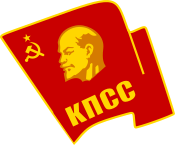More languages
More actions
The Communist Party of the Soviet Union (CPSU),[a] was a communist party tracing back to the Russian Social Democratic Labor Party (RSDLP), which was established in its second congress, in 1903.[1] The party brought together the vanguard of the Soviet people in the construction of socialist society.
Its predecessor, the RSDLP, had split into Bolshevik and Menshevik factions in 1903. The CPSU emerged in continuity with the Bolshevik political line.
The Bolsheviks changed their name to the Communist Party of Russia (Bolsheviks) in 1918, the All-Union Communist Party (Bolsheviks) in 1925, and the Communist Party of the Soviet Union (Communist Party of the Soviet Union) in 1952.
Names
History
Russian Social Democratic Labour Party
In 1898 the Russian Social Democratic Labor Party was created, uniting the several communist study groups scattered around Russia. Among its founders were people like Vladimir Lenin and Julius Martov. It established itself as a Marxist party that had the task of overthrowing the monarchy and bring about socialism. However during the course of the struggle there was a lot of disagreement about when this goal was to be implemented and how. In 1903 emerged a de facto split in the party, and two factions were formed: the Mensheviks led by Martov and the Bolsheviks led by Lenin.
Although Lenin and many others first anticipated the two groups could merge again, the split ended up worsening and the two factions became separate parties: the Russian Social-Democratic Labour Party (Mensheviks) and the Russian Social-Democratic Labour Party (Bolsheviks).
The main differences between the groups were the following:
1. The Bolsheviks wanted an organisationally united party of serious revolutionaries while the Mensheviks wanted a more loose reformist party.
2. Both parties agreed that the next course of action was to overthrow the monarchy and carry out the so-called “bourgeois-democratic revolution.” This would make Russia a capitalist parliamentary democracy. However the Mensheviks argued that the class to lead the revolution was the bourgeoisie, the capitalist class, as the bourgeois class served this function in the French Revolution. The Bolsheviks disagreed, they thought the capitalists couldn’t be trusted to carry out the democratic revolution: they were weaker than the bourgeoisie in France at the time, they allied with the monarchy, and they feared the workers and peasants. In fact, Lenin argued that the Russian proletariat was much stronger and more developed than the French proletariat of the late 1700s and therefore should lead the democratic revolution, and not merely support it.
3. Lastly, the Mensheviks didn’t think Russia was ready for socialism, in their opinion the workers could never take power in Russia until after a long time of capitalist and parliamentary development. Even though the debate about workers revolution and socialism would only come about fully later, this attitude relates to the Menshevik position that the workers shouldn’t lead the democratic revolution, but only support the capitalist class against the monarchy.
Membership
In 1972, the majority of CPSU members were Russians but Georgians made up the highest ratio of party members per capita, followed by Russians and then Armenians. Moldovans were the most underrepresented nationality in the party.[2]
References
- ↑ “Notwithstanding the fact that the First Congress of the Russian Social-Democratic Party had been held in 1898, and that it had announced the formation of the Party, no real party was as yet created. There was no party program or party rules. The Central Committee of the Party elected at the First Congress was arrested and never replaced, for there was nobody to replace it. Worse still, the ideological confusion and lack of organizational cohesion of the Party became even more marked after the First Congress.
[...]
Iskra linked up the scattered Social-Democratic circles and groups and prepared the way for the convocation of the Second Party Congress. At the Second Congress, held in 1903, the Russian Social-Democratic Labour Party was formed, a Party Program and Rules were adopted, and the central leading organs of the Party were set up.”
Central Committee of the CPSU (1938). History of the Communist Party of the Soviet Union (Bolsheviks): 'Formation of the Russian Social-Democratic Labour Party. Appearance of the Bolshevik and the Menshevik groups within the party'. [MIA] - ↑ Albert Szymanski (1984). Human Rights in the Soviet Union: 'The Asian Nationalities in the USSR' (p. 59). London.

